Roger Dannenberg
YuE: Scaling Open Foundation Models for Long-Form Music Generation
Mar 11, 2025Abstract:We tackle the task of long-form music generation--particularly the challenging \textbf{lyrics-to-song} problem--by introducing YuE, a family of open foundation models based on the LLaMA2 architecture. Specifically, YuE scales to trillions of tokens and generates up to five minutes of music while maintaining lyrical alignment, coherent musical structure, and engaging vocal melodies with appropriate accompaniment. It achieves this through (1) track-decoupled next-token prediction to overcome dense mixture signals, (2) structural progressive conditioning for long-context lyrical alignment, and (3) a multitask, multiphase pre-training recipe to converge and generalize. In addition, we redesign the in-context learning technique for music generation, enabling versatile style transfer (e.g., converting Japanese city pop into an English rap while preserving the original accompaniment) and bidirectional generation. Through extensive evaluation, we demonstrate that YuE matches or even surpasses some of the proprietary systems in musicality and vocal agility. In addition, fine-tuning YuE enables additional controls and enhanced support for tail languages. Furthermore, beyond generation, we show that YuE's learned representations can perform well on music understanding tasks, where the results of YuE match or exceed state-of-the-art methods on the MARBLE benchmark. Keywords: lyrics2song, song generation, long-form, foundation model, music generation
ChatMusician: Understanding and Generating Music Intrinsically with LLM
Feb 25, 2024
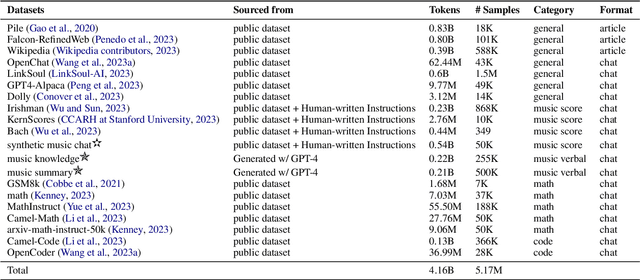


Abstract:While Large Language Models (LLMs) demonstrate impressive capabilities in text generation, we find that their ability has yet to be generalized to music, humanity's creative language. We introduce ChatMusician, an open-source LLM that integrates intrinsic musical abilities. It is based on continual pre-training and finetuning LLaMA2 on a text-compatible music representation, ABC notation, and the music is treated as a second language. ChatMusician can understand and generate music with a pure text tokenizer without any external multi-modal neural structures or tokenizers. Interestingly, endowing musical abilities does not harm language abilities, even achieving a slightly higher MMLU score. Our model is capable of composing well-structured, full-length music, conditioned on texts, chords, melodies, motifs, musical forms, etc, surpassing GPT-4 baseline. On our meticulously curated college-level music understanding benchmark, MusicTheoryBench, ChatMusician surpasses LLaMA2 and GPT-3.5 on zero-shot setting by a noticeable margin. Our work reveals that LLMs can be an excellent compressor for music, but there remains significant territory to be conquered. We release our 4B token music-language corpora MusicPile, the collected MusicTheoryBench, code, model and demo in GitHub.
MARBLE: Music Audio Representation Benchmark for Universal Evaluation
Jul 12, 2023Abstract:In the era of extensive intersection between art and Artificial Intelligence (AI), such as image generation and fiction co-creation, AI for music remains relatively nascent, particularly in music understanding. This is evident in the limited work on deep music representations, the scarcity of large-scale datasets, and the absence of a universal and community-driven benchmark. To address this issue, we introduce the Music Audio Representation Benchmark for universaL Evaluation, termed MARBLE. It aims to provide a benchmark for various Music Information Retrieval (MIR) tasks by defining a comprehensive taxonomy with four hierarchy levels, including acoustic, performance, score, and high-level description. We then establish a unified protocol based on 14 tasks on 8 public-available datasets, providing a fair and standard assessment of representations of all open-sourced pre-trained models developed on music recordings as baselines. Besides, MARBLE offers an easy-to-use, extendable, and reproducible suite for the community, with a clear statement on copyright issues on datasets. Results suggest recently proposed large-scale pre-trained musical language models perform the best in most tasks, with room for further improvement. The leaderboard and toolkit repository are published at https://marble-bm.shef.ac.uk to promote future music AI research.
On the Effectiveness of Speech Self-supervised Learning for Music
Jul 11, 2023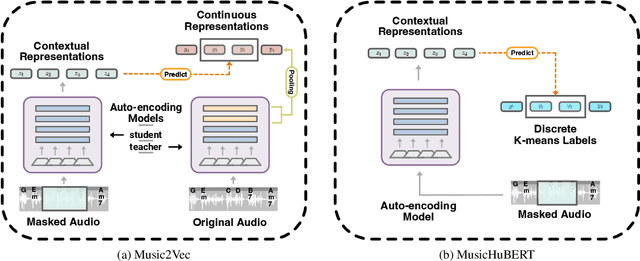



Abstract:Self-supervised learning (SSL) has shown promising results in various speech and natural language processing applications. However, its efficacy in music information retrieval (MIR) still remains largely unexplored. While previous SSL models pre-trained on music recordings may have been mostly closed-sourced, recent speech models such as wav2vec2.0 have shown promise in music modelling. Nevertheless, research exploring the effectiveness of applying speech SSL models to music recordings has been limited. We explore the music adaption of SSL with two distinctive speech-related models, data2vec1.0 and Hubert, and refer to them as music2vec and musicHuBERT, respectively. We train $12$ SSL models with 95M parameters under various pre-training configurations and systematically evaluate the MIR task performances with 13 different MIR tasks. Our findings suggest that training with music data can generally improve performance on MIR tasks, even when models are trained using paradigms designed for speech. However, we identify the limitations of such existing speech-oriented designs, especially in modelling polyphonic information. Based on the experimental results, empirical suggestions are also given for designing future musical SSL strategies and paradigms.
LyricWhiz: Robust Multilingual Zero-shot Lyrics Transcription by Whispering to ChatGPT
Jul 07, 2023



Abstract:We introduce LyricWhiz, a robust, multilingual, and zero-shot automatic lyrics transcription method achieving state-of-the-art performance on various lyrics transcription datasets, even in challenging genres such as rock and metal. Our novel, training-free approach utilizes Whisper, a weakly supervised robust speech recognition model, and GPT-4, today's most performant chat-based large language model. In the proposed method, Whisper functions as the "ear" by transcribing the audio, while GPT-4 serves as the "brain," acting as an annotator with a strong performance for contextualized output selection and correction. Our experiments show that LyricWhiz significantly reduces Word Error Rate compared to existing methods in English and can effectively transcribe lyrics across multiple languages. Furthermore, we use LyricWhiz to create the first publicly available, large-scale, multilingual lyrics transcription dataset with a CC-BY-NC-SA copyright license, based on MTG-Jamendo, and offer a human-annotated subset for noise level estimation and evaluation. We anticipate that our proposed method and dataset will advance the development of multilingual lyrics transcription, a challenging and emerging task.
MERT: Acoustic Music Understanding Model with Large-Scale Self-supervised Training
Jun 06, 2023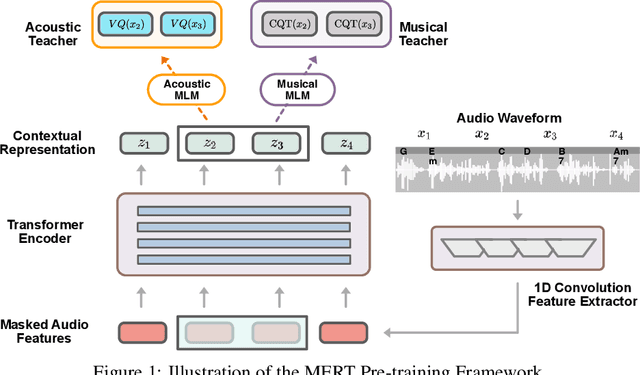

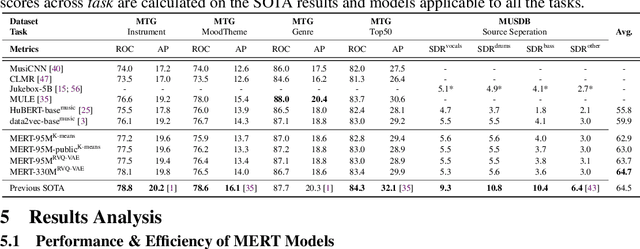
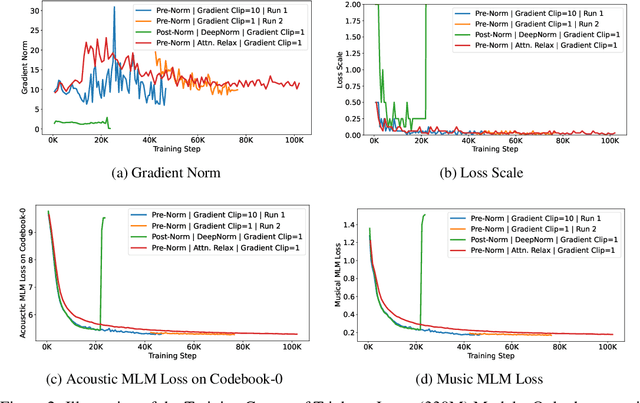
Abstract:Self-supervised learning (SSL) has recently emerged as a promising paradigm for training generalisable models on large-scale data in the fields of vision, text, and speech. Although SSL has been proven effective in speech and audio, its application to music audio has yet to be thoroughly explored. This is primarily due to the distinctive challenges associated with modelling musical knowledge, particularly its tonal and pitched characteristics of music. To address this research gap, we propose an acoustic Music undERstanding model with large-scale self-supervised Training (MERT), which incorporates teacher models to provide pseudo labels in the masked language modelling (MLM) style acoustic pre-training. In our exploration, we identified a superior combination of teacher models, which outperforms conventional speech and audio approaches in terms of performance. This combination includes an acoustic teacher based on Residual Vector Quantization - Variational AutoEncoder (RVQ-VAE) and a musical teacher based on the Constant-Q Transform (CQT). These teachers effectively guide our student model, a BERT-style transformer encoder, to better model music audio. In addition, we introduce an in-batch noise mixture augmentation to enhance the representation robustness. Furthermore, we explore a wide range of settings to overcome the instability in acoustic language model pre-training, which allows our designed paradigm to scale from 95M to 330M parameters. Experimental results indicate that our model can generalise and perform well on 14 music understanding tasks and attains state-of-the-art (SOTA) overall scores. The code and models are online: https://github.com/yizhilll/MERT.
Relating Human Perception of Musicality to Prediction in a Predictive Coding Model
Oct 29, 2022



Abstract:We explore the use of a neural network inspired by predictive coding for modeling human music perception. This network was developed based on the computational neuroscience theory of recurrent interactions in the hierarchical visual cortex. When trained with video data using self-supervised learning, the model manifests behaviors consistent with human visual illusions. Here, we adapt this network to model the hierarchical auditory system and investigate whether it will make similar choices to humans regarding the musicality of a set of random pitch sequences. When the model is trained with a large corpus of instrumental classical music and popular melodies rendered as mel spectrograms, it exhibits greater prediction errors for random pitch sequences that are rated less musical by human subjects. We found that the prediction error depends on the amount of information regarding the subsequent note, the pitch interval, and the temporal context. Our findings suggest that predictability is correlated with human perception of musicality and that a predictive coding neural network trained on music can be used to characterize the features and motifs contributing to human perception of music.
 Add to Chrome
Add to Chrome Add to Firefox
Add to Firefox Add to Edge
Add to Edge